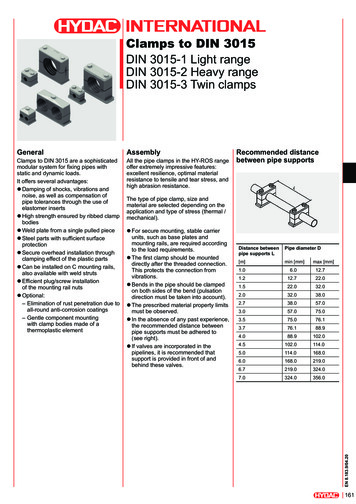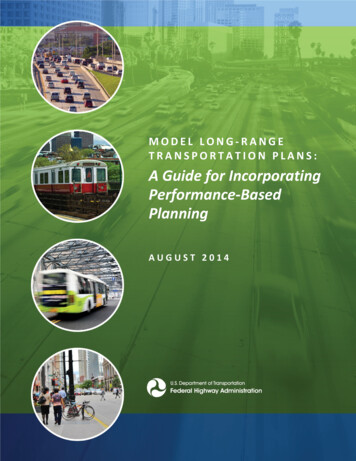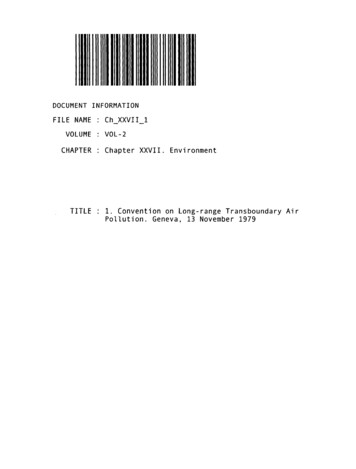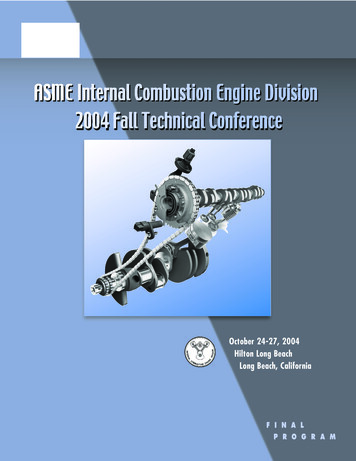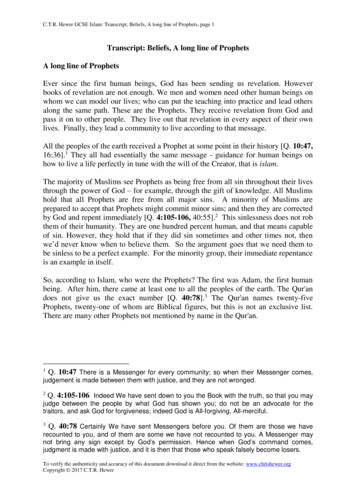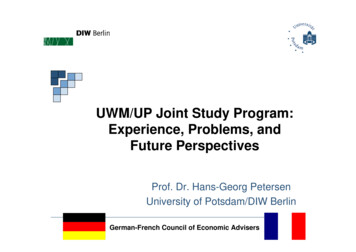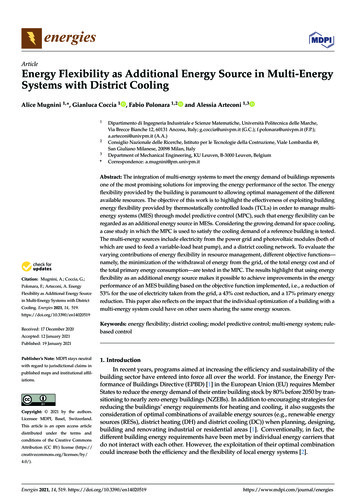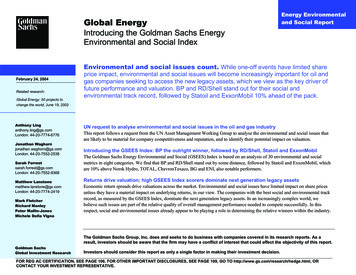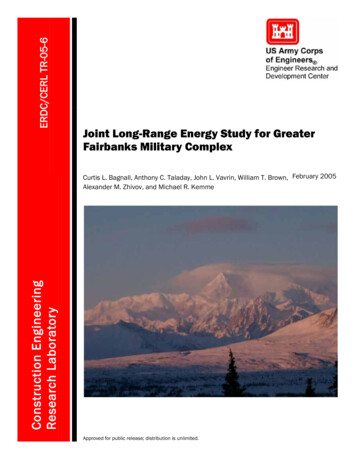
Transcription
ERDC/CERL TR-05-6Joint Long-Range Energy Study for GreaterFairbanks Military ComplexConstruction EngineeringResearch LaboratoryCurtis L. Bagnall, Anthony C. Taladay, John L. Vavrin, William T. Brown, February 2005Alexander M. Zhivov, and Michael R. KemmeApproved for public release; distribution is unlimited.
ERDC/CERL TR-05-6February 2005Joint Long-Range Energy Study forGreater Fairbanks Military ComplexCurtis L. Bagnall, Anthony C. Taladay, John L. Vavrin, William T. Brown,Alexander M. Zhivov, and Michael R. KemmeConstruction Engineering Research Laboratory (CERL)U.S. Army Engineer Research and Development Center2902 Newmark Dr.Champaign, IL 61822-1076Final ReportApproved for public release; distribution is unlimited.Prepared forUnderHeadquarters, U.S. Army Corps of EngineersWashington, DC 20314-1000Work Unit No. CFE-GB03
ERDC/CERL TR-05-6Abstract: This study evaluated onsite and regional options for providingheat and power to Fort Wainwright, Eielson Air Force Base, Fort Greely,and the Ground-Based Midcourse Defense installation adjacent to FortGreely, collectively known as the Greater Fairbanks Military Complex(GFMC). The alternatives evaluated include site-specific alternatives(continued operation of existing plant and new plant) and regionalalternatives to provide power or both heat and power. The report providesbackground information on the energy supply situation in Interior Alaska,the availability of fuels, and the existing energy infrastructure and reviewsthe suitability of possible technologies for long-term heat and powersolutions for the GFMC installations. The report also develops evaluationcriteria for fuels and alternative heat and power solutions. Life-cycle costsare developed for each alternative and are used in the evaluation alongwith other criteria such as security, impact on Alaska infrastructure, andair and water quality. Results of the analysis are presented to allow theDepartment of Defense to make an informed decision about heat andpower solutions for the installations.DISCLAIMER: The contents of this report are not to be used for advertising, publication, or promotional purposes.Citation of trade names does not constitute an official endorsement or approval of the use of such commercial products.All product names and trademarks cited are the property of their respective owners. The findings of this report are not tobe construed as an official Department of the Army position unless so designated by other authorized documents.DESTROY THIS REPORT WHEN NO LONGER NEEDED. DO NOT RETURN IT TO THE ORIGINATOR.ii
ERDC/CERL TR-05-6Executive SummaryIn May 2003, the Assistant Chief of Staff for Installation Management(ACSIM) requested that the U.S. Army Engineer Research and Development Center (ERDC), Construction Engineering Research Laboratory(CERL) conduct a Joint Long-Range Energy Study for Fort Wainwright(FWA), Fort Greely (FGA), the Ground-Based Midcourse Defense (GMD)installation adjacent to FGA, and Eielson Air Force Base (EAFB), collectively referred to as the Greater Fairbanks Military Complex (GFMC).ERDC awarded a contract to CH2M HILL in August 2003 to perform thetechnical study.The goal of this joint study was to assess the options for long-range regional heat and power in the GFMC area and provide recommendedcourses of action to achieve environmentally responsible, reliable, andeconomically viable heat and electric power based on a 25-year period.This study provides the Services (U.S. Army and U.S. Air Force) and theMissile Defense Agency (MDA) with recommendations on regional andinstallation-specific approaches to the provision of heat and power supplyfor the GFMC installations.The tasks for achieving the objectives of the study included (1) the evaluation of fuel options and regional and installation-specific alternatives forheat and power supply, and (2) a review of possible power-generatingtechnologies, including renewable resources. The evaluation was done independently of specific ownership considerations. The following alternatives for providing heat and electric power to the GFMC were evaluated: Regional Electric Power Plant. This alternative involves building aregional electric power plant to meet the mission-required electricityneeds of the installations over and above the electricity generation atthe existing FWA and EAFB Central Heat and Power Plants (CHPPs),which is produced as a by-product of heat production. The plant couldbe either coal- or oil-fired.Regional Heat and Electric Power Plant. This alternative involves building a regional CHPP to meet the combined heating demands of FWA and EAFB and the mission-required electricity needs ofall of the installations. The plant would most likely be located on EAFBto avoid the Fairbanks carbon monoxide (CO) management/nonattainment area (NAA). This solution would require the construction ofiii
ERDC/CERL TR-05-6 a long-distance heat transmission system to FWA and to interconnectto the existing EAFB system. Similar to the regional electric powerplant, a regional CHPP could be either coal- or oil-fired.Repair. This alternative involves building continuing operation of theexisting CHPPs, accomplishing appropriate repairs, and buying additional power needs from Golden Valley Electric Association (GVEA). Inthis alternative, steam is produced to meet heating load, and additionalsteam is generated specifically to produce electricity, but only to thelimit of the existing CHPP design capacity.Repair and Upgrade. This alternative is similar to the Repair alternative except that additional new electrical generation capacity is added to the CHPPs to meet future electricity demands. This alternativeminimizes or eliminates electricity purchases from GVEA even as demand at the military installations increases.Repair, Using Electricity Produced by “Following the HeatCurve.” This alternative is similar to the Repair alternative except thatelectricity generation would be based on heat loads only. Unlike theRepair and Repair and Upgrade alternatives, no steam would be produced solely for electric power generation beyond what is needed tomeet heating loads.Upgrade Coal-Fired Boilers with New Circulating FluidizedBed Boilers (CFBs). EAFB anticipates replacing two current boilerswith two new boilers. This alternative was evaluated for EAFB only;FWA does not have similar plans.New Coal-Fired CHPP. This alternative involves building a newstandalone CHPP to meet the projected installation heat and electricityneeds.New Oil- or Gas-Fired CHPP. This alternative involves building anew standalone CHPP to meet the projected installation heat and electricity needs.Based on the evaluations, construction of new installation-specific coalfired CHPPs was the highest ranked and lowest life-cycle cost alternativefor both FWA and EAFB. This alternative has estimated capital construction costs of 201 million at FWA and 188 million at EAFB. All four regional alternatives have higher life-cycle costs than the installationspecific alternative. The regional option with the lowest capital cost is anoil- or natural gas–fired combustion turbine (CT) and heat recovery steamgenerator (HRSG) electrical power plant. Under this option, the existingFWA and EAFB plants would continue to be the source of heat and cogenerated electricity.iv
ERDC/CERL TR-05-6Sensitivity of the evaluation results was tested by weighting the variouscriteria and individual scores. The major criteria in the evaluation weresecurity (40 percent) and life-cycle costs (30 percent). Significant changesin the criteria weighting were required to significantly change the results.Without significant changes to the weighting, changes in individual scoresfor a particular criterion have minimal effect.The report concludes and recommends: Coal is the most secure fuel available in Interior Alaska.Regional solutions are more expensive and less secure than installation-specific solutions.Over the study period (2004 to 2028) with new plants coming online in2012, new coal-fired CHPPs at FWA and EAFB are the highest rankedsolutions.Because of its location, FGA has no economically justified regional solution. Electricity should be purchased directly from GVEA rather thangenerated at FWA and transmitted over the GVEA system. After including losses and GVEA transmission charges, it is less expensive tobuy directly from GVEA.The U.S. Department of Defense (DoD) should participate collectivelyfor the GFMC installations in the local electric utility’s (GVEA’s) nextrate-making process (anticipated to occur in 2005) to ensure that itsinterests are represented with regard to the demand charge, transmission system use charges, cost allocations, and rate structure.Installations should work and participate with GVEA to pursue development of wind energy.FWA, FGA, and EAFB should evaluate conversion of their heat distribution systems from steam to hot water, as hot water distribution maybe more cost-effective than steam.The next steps are to: develop sufficient project definition to support DD Form 1391 budgetlevel cost estimates for new coal-fired CHPPs at FWA and EAFB andfor two new coal-fired CFBs at EAFBupdate the life-cycle cost analysis for the DD Form 1391 cost estimateschoose alternative(s) and include them in the appropriate MilitaryConstruction program plan.v
ERDC/CERL TR-05-6ContentsExecutive Summary . iiiFigures and Tables . xiPreface .xvUnit Conversion Factors . xviii1Introduction . 1Background . 1Objective . 3Approach . 4Scope . 5Mode of Technology Transfer . 52Project Overview . 6Greater Fairbanks Military Complex . 6Projected Electrical Loads . 6Renewable Energy Resources . 8Fuel Alternatives and Evaluation . 8Environmental Considerations . 10Electricity Considerations . 10FGA and GMD Solutions. 10Current Situation at FWA and EAFB . 10Alternatives Evaluated for FWA and EAFB . 11Life-Cycle Cost Evaluation . 11Alternatives Evaluation . 14Evaluation Results . 16Sensitivity Analysis . 16Additional Insights . 173Energy-Related Considerations in Alaska.18Interior Alaska Climate . 181.1 Alaska Utility Regulatory Considerations . 22General Background . 22Energy Utility Supplies Provided in Bulk from Off-Installation Entities . 23Regulation of Energy Utility Services within the Military Installations . 26Conclusions Regarding Regulatory Constraints and Allowances . 28Fuels in Interior Alaska . 30Coal . 30Oil . 33Natural Gas/LNG. 35Fuels Security . 374Golden Valley Electric Association .41GVEA Power Supply . 41vi
ERDC/CERL TR-05-6GVEA Electrical Transmission System . 46Historical Outages . 47GVEA Backup Power Generation . 52Military Power Sales to GVEA . 53GVEA Service to FWA, EAFB, FGA, and GMD . 55Wheeling from FWA to FGA . 55GVEA Rate Schedule General Service 2 (GS-2) . 55Analysis of GVEA Power Bills to Installations . 57GVEA Rates . 63State of Alaska Energy Plan . 635Strategic Energy Forum .676Ownership Options.71Feasibility of Heating and Power System Privatization. 71Evaluation Factors . 72Recommendations . 76Feasibility of Leasing Heating and Power Systems . 77General Advantages and Disadvantages. 77Enhanced Use Leasing . 78Recommendation . 797Installation Heat and Power System Descriptions.80FWA Heat and Power Systems . 80Central Heat and Power Plant . 80Repair Projects . 83EAFB Heat and Power Systems . 86Central Heat and Power Plant . 86Eielson Boiler Rehabilitation Projects . 89FGA Heat and Power Systems . 93Central Heat and Power Plant . 93CHPP Improvement Projects. 96GMD Heat and Power Systems . 968Future Load Growth at All Installations .97Background . 97Steam Heat Loads. 98Electrical Loads . 99Projected Loads . 99FWA and EAFB . 99FGA. 101GMD . 1039Existing Reliability for Heat and Power . 105Existing Installation Approach for Heat and Power . 105Steam Generation .
sion system use charges, cost allocations, and rate structure. Installations should work and participate with GVEA to pursue deve l-opment of wind energy. FWA, FGA, and EAFB should evaluate conversion of their heat distri-bution systems from steam to hot water, as hot
